NCERT Exemplar Class 12 Chemistry Chapter 12 Aldehydes, Ketones and Carboxylic Acids are part of NCERT Exemplar Class 12 Chemistry . Here we have given NCERT Exemplar Class 12 Chemistry Chapter 12 Aldehydes, Ketones and Carboxylic Acids.
NCERT Exemplar Class 12 Chemistry Chapter 12 Aldehydes, Ketones and Carboxylic Acids
Multiple Choice Questions
Single Correct Answer Type
Question 1. Addition of water to alkynes occurs in acidic medium and in the presence of Hg
2+
ions as a catalyst. Which one of the following product will be formed on addition of water to but-l-yne under these conditions?

Solution:
(b)

Question 2. Which of the following compounds is most reactive towards nucleophilic addition reactions?

Solution:
(a) CH
3
CHO is most reactive towards nucleophilic addition reactions. Carbonyl compounds are polar with positive charge on carbon atom which is attacked by nucleophiles. Two electron releasing alkyl groups in ketones make carbon less electron deficient than aldehydes. Benzene ring exhibits + R-effect which thereby decreases the ease of nucleophilic addition reaction in benzaldehyde and acetophenone. Hence the reactivity order is

Question 3. The correct order of increasing acidic strength is
(a) Phenol < Ethanol < Chloroacetic acid < Acetic acid
(b) Ethanol < Phenol < Chloroacetic acid < Acetic acid
(c) Ethanol < Phenol Acetic acid < Eihloroacetic acid
(d) Chloroacetic acid < Acetic acid < Phenol < Ethanol
Solution:
(c) Phenol is more stable than alcohol due to formation of more stable conjugate base after removal of H
+
from phenol.

Question 4.

Solution:
(b) C
6
H
5
OCOC
6
H
5
can be prepared by the reaction of phenol and benzoyl chloride in the presence of pyridine.

Question 5. The reagent which does not react with both acetone and benzaldehyde is
(a) sodium hydrogen sulphite
(c) Fehling’s solution
Solution:
(c) Fehling’s solution oxidises aliphatic aldehydes very easily but does not react with acetone and benzaldehyde.
Question 6. Cannizzaro’s reaction is not given by

Solution:
(d) CH
3
CHO will not give Cannizzaro’s reaction because it contains a-hydrogen while other three compounds have no a-hydrogen. Hence, they will give Cannizzaro’s reaction.
Question 7.
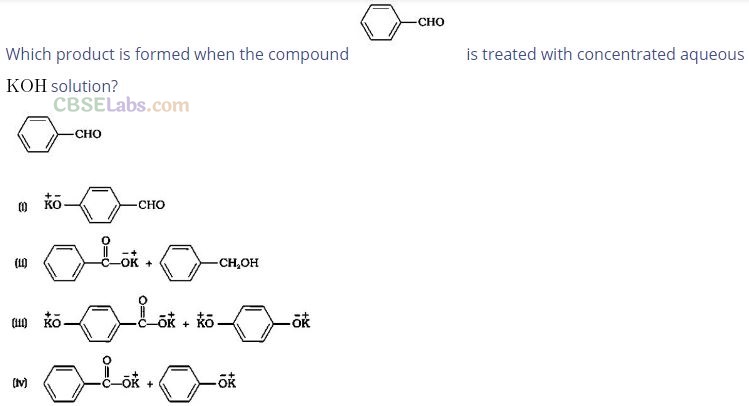
Solution:
(b) Benzaldehyde is having no a hydrogen. So, on reaction with aqueous KOH solution, it undergoes Cannizzaro’s reaction. One molecule of aldehyde is reduced and other is

Question 8.
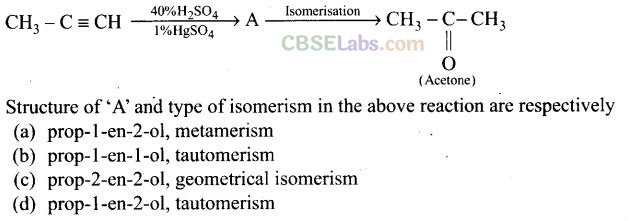
Solution: (d)

Question 9. Compounds A and C in the following reactions are
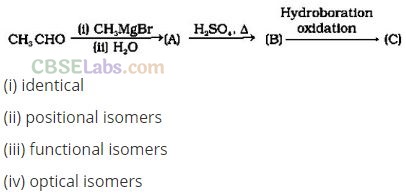
Solution:
(b)
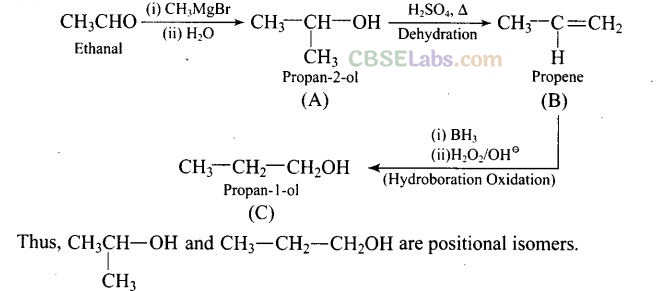
Question 10. Which is the most suitable reagent for the following conversion?

Solution:
(c)

Question 11. Which of the following compounds will give butanone on oxidation with alkaline KMnO
4
solution?
(a) Butan-l-ol (b) Butan-2-ol
(c) Both (a) and (b) (d) None of these
Solution:

Question 12. In Clemmensen reduction carbonyl compound is treated with
(a) zinc amalgam + HCl (b) sodium amalgam + HCl
(c) zinc amalgam + nitric acid (d) sodium amalgam + HNO
3
Solution:
(a) Clemmensen reduction is used to convert carbonyl group to CH
2
group as follows

More than One Correct Answer Type
Question 13. Which of the following compounds do not undergo aldol condensation?

Solution:
(b, d)

In these compounds, a-hydrogen is absent. So, aldol condensation does not take place in these compounds.
Question 14.

Solution:
(b, c)
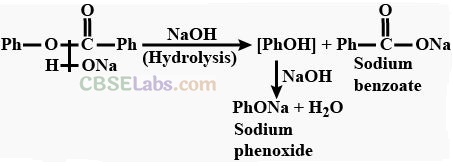
Question 15. Which of the following conversions can be carried out by Clemmensen reduction?
(a) Benzaldehyde into benzyl alcohol
(b) Cyclohexanone into cyclohexane
(c) Benzoyl chloride into benzaldehyde
(d) Benzophenone into diphenylmethane
Solution:
(b, d)
Clemmensen reduction is used to convert cyclohexanone into cyclohexane and benzophenone into diphenyl methane.
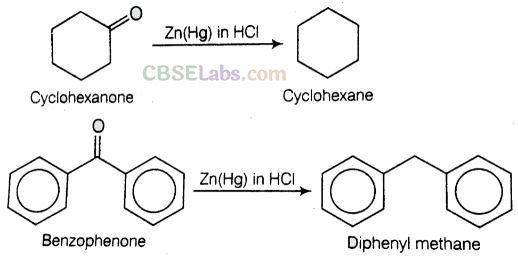
Question 16. Through which of the following reactions number of carbon atoms can be increased in the chain?
(a) Grignard reaction (b) Cannizzaro’s reaction
(c) Aldol condensation (d) HVZ reaction
Solution:
(a, c) Grignard reagent is used to add number of carbon atom in chain.

Question 17. Benzophenone can be obtained by
(a) benzoyl chloride + benzene + AlCl
3
(b) benzoyl chloride + diphenylcadmium
(c) benzoyl chloride + phenylmagnesium chloride
(d) benzene + carbon monoxide + ZnCl
2
Solution:
(a, b)
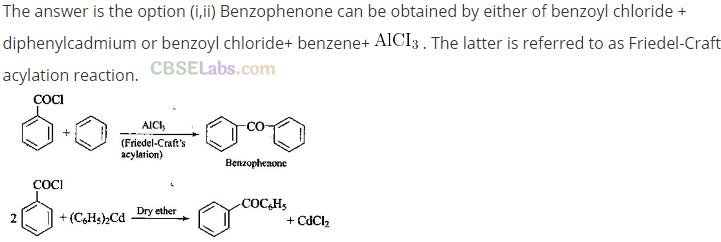
Question 18. Which of the following is the correct representation for intermediate of nucleophilic addition reaction to the given carbonyl compound (A):

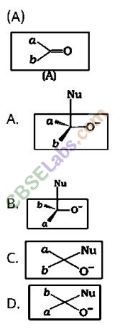
Solution:
(a, b) Since, carbonyl compound is a planar molecule hence two orientation of molecule regarding attack of nucleophile is possible as follows
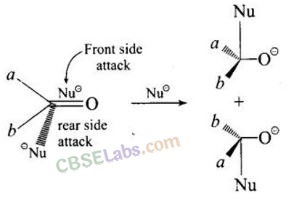
Since, the product contains a chiral carbon, therefore, attack of nucleophile can occur either from front side attack or rear side attack giving enantiomeric products.
Short Answer Type Questions
Question 19. Why is there a large difference in the boiling points of butanal and butan-1 -ol?
Solution:
Butan-1 -ol has higher boiling point (391 K) than butanal due to intermolecular hydrogen bonding between -OH groups of alcohols.
Question 20. Write a test to differentiate between pentan-2-one and pentan-3-one.
Solution:

Question 21. Give the IUPAC names of the following compounds:

Solution:
(a) 3-Phcnylprop-2-en-1 -al
(b) Cyclohexanecarbaldehyde
(c) 3-Oxopentan-l-al
(d) But-2-en-l-al
Question 22. Give the structure of the following compounds:
(a) 4-Nitropropiophenone
(b) 2-Hydroxycyclopentane + carbaldehyde
(c) Phenyl acetaldehyde
Solution:
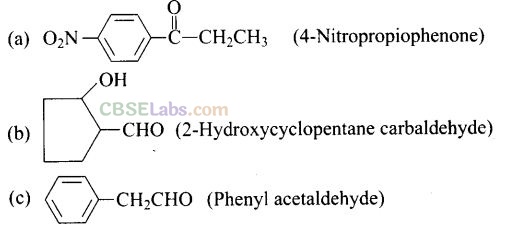
Question 23. Write IUPAC names of the following structures:

Solution:
(a) Ethane-1,2-dial
(b) Benzene-1, 4-dicarbaldehyde
(c) 3-Bromobenzaldehyde
Question 24. Benzaldehyde can be obtained from benzalchloride. Write reactions for obtaining benzalchloride and then benzaldehyde form it.
Solution:

Question 25. Name the electrophile produced in the reaction of benzene with benzoyl chloride in the presence of anhydrous AlCl
3
. Name of the reaction also.
Solution:

Question 26. Oxidation of ketones involves carbon-carbon bond cleavage. Name the products formed on oxidation of 2, 5-dimethylhexan-3-one.
Solution:

Question 27. Arrange the following in decreasing order of their acidic strength and give reason for your answer.
Solution:
CH
3
CH
2
OH, CH
3
COOH, CICH
2
COOH, FCH
2
COOH, C
6
H
5
CH
2
COOH
FCH
2
COOH > ClCH
2
COOH > C
6
H
5
CH
2
COOH > CH
3
COOH > CH3CH
2
OH
[This is due to -I effect and acidic strength increases proportionately with the increase in electronegativity.
(i.e., F > Cl > C
6
H
5
> H).
Further CH
3
COOH is much stronger acid than CH
3
CH
2
OH because CH
3
COO
–
ion that has left after the loss of proton is stabilised by resonance but CH
3
CH
2
O
–
does not.]
Question 28. What products will be formed on reaction of propanal with 2-methylpropanal in the presence of NaOH? Write the name of the reaction also.
Solution:
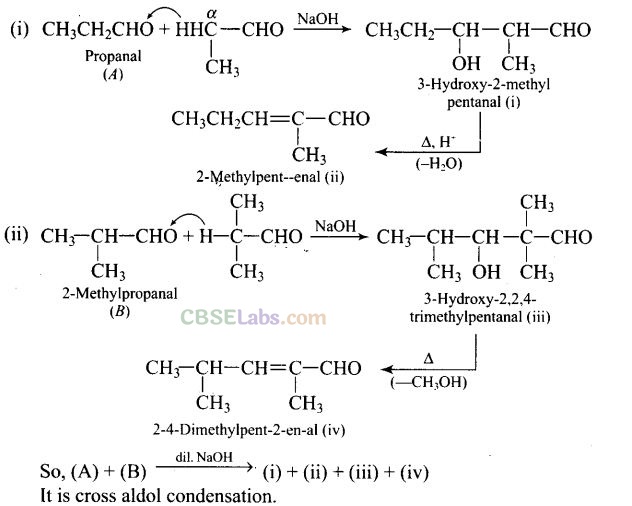
Question 29. Compound ‘A’ was prepared by oxidation of compound ‘B’ with alkaline KMnO
4
. Compound ‘A’ on reduction with lithium aluminium hydride gets converted back to compound ‘B’. When compound ‘A’ is heated with compound ‘B’ in the presence of H
2
SO
4
it produces fruity smell of compound ‘C’ to which family the compounds ‘A’, ‘B’ and ‘C’ belong to?
Solution:
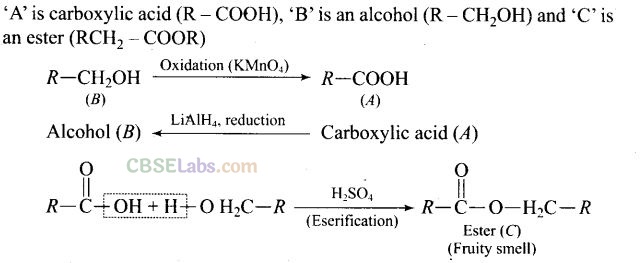
Question 30. Arrange the following in decreasing order of their acidic strength. Give explanation for the arrangement.
C
6
H
5
COOH, FCH
2
COOH, NO
2
CH
2
COOH
Solution:
NO
2
CH
2
COOH > FCH
2
COOH > C
6
H
5
COOH
-NO
2
and -F groups are electron withdrawing groups. Out of the two -NO
2
has greater electron withdrawing effect. C
6
H
5
-group has electron denoting effect.
Question 31. Alkenes (>C = C<) and carbonyl compounds (>C = O), both contain a rc-bond but alkenes show electrophilic addition reactions whereas carbonyl compounds show nucleophilic addition reactions. Explain.
Solution:
Carbonyl group is polar in nature. Due to larger electronegativity of oxygen as compared to carbon, carbon acquires partial positive charge while O acquires partial negative charge.

Because of slight positive charge on C atom, it is attacked by nucleophiles and, therefore, undergoes nucleophilic addition reaction.
Ethylenic double bond is a non-polar bond and is a source of electrons. Therefore, it is attacked by electrophiles and undergoes electrophilic addition reactions.
Question 32. Carboxylic acids contain carbonyl group but do not show the nucleophilic addition reaction like aldehydes or ketones. Why?
Solution:
It is due to resonance as shown below. The partial positive charge on the carbonyl carbon atom is reduced

Similarly, a carbonyl group of aldehydes and ketones may be regarded as the resonance hybrid of the following structures.

The carbonyl carbon of carboxylic group is less electrophilic than carbonyl carbon in aldehydes and ketones and hence nucleophilic addition reactions of aldehydes and ketones do not takes place with carboxylic acids.
Question 33. Identify the compounds A, B and C in the following reaction.
![]()
Solution:
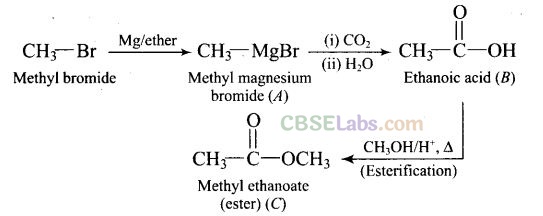
Question 34. Why are carboxylic acids more acidic than alcohols or phenols although all of them have hydrogen atom attached to an oxygen atom (-O-H)?
Solution:
The aliphatic carboxylic acids are stronger acids than alcohols and phenols. The difference in the relative acidic strengths can be understood if we compare the resonance hybrids of carboxylate ion and ethoxide phenoxide ion.

The resonance hybrids may be represented as:
Carboxylate ion Phenoxide ion (No resonance)
The electron charge on the carboxylate ion is more dispersed in comparison to the phenate ion since there are two electronegative oxygen atoms in carboxylate ion as compared to only one oxygen atom in phenoxide ion. In other words, the carboxylate ion is relatively more stable as compared to phenate ion. Thus, the release of H
+
ion from carboxylic acid is comparatively easier or it behaves as a stronger acid than phenol.
Question 35. Complete the following reaction sequence.

Solution:
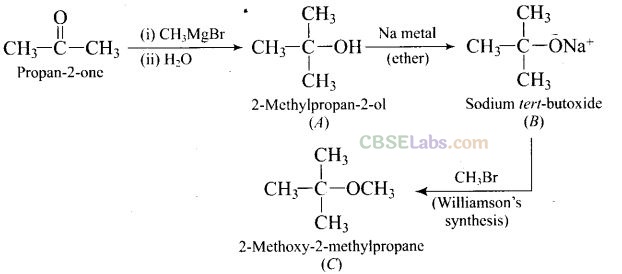
Question 36. What happen when benzene diazonium chloride is heated with water?
Solution:

In (ii) reaction, it readily undergoes further alkylation to produce polysubs- tituted derivative.
Question 37. Can Gattermann-Koch reaction be considered similar to Friedel-Crafts acylation? Discuss.
Solution:
Gattermann-Koch reaction is formylation (introduction of-CHO group) to the benzene nucleus.
Friedel-Crafts acylation reaction is introduction of RCO— group in the benzene ring.
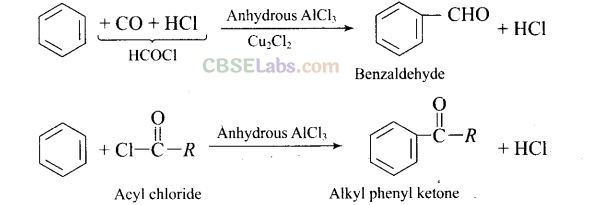
In Friedel-Crafts acylation reactions, the benzene is treated with an acid chloride in presence of anhydrous AlCl
3
. So, Gattermann-Koch reaction can be considered similar to Friedel-Crafts acylation reaction.
Matching Column Type Questions
Question 38. Match the common names given in Column I with the IUPAC names given in Column II.
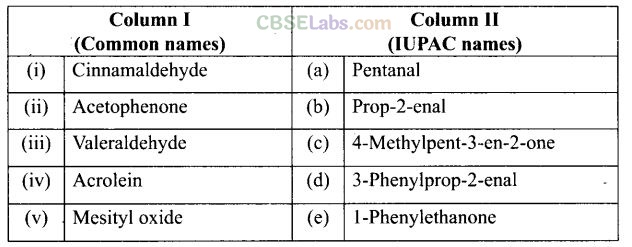
Solution:
(i —> d), (ii —» e), (iii —> a), (iv —> b), (v -> c)
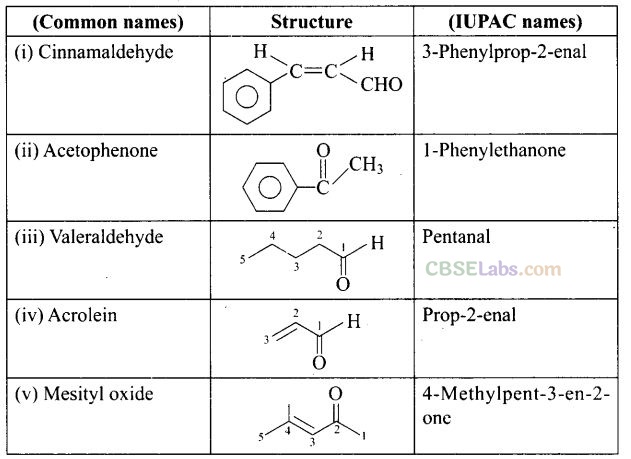
Question 39. Match the acids given in Column 1 with their correct IUPAC names given in Column II.
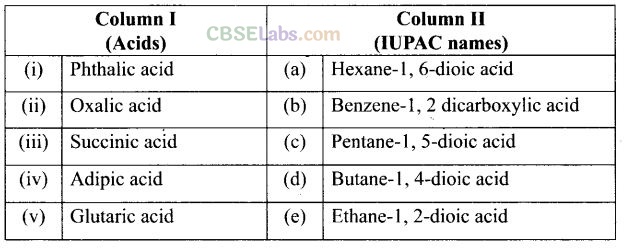
Solution:
(i —> b), (ii —> e), (iii —> d), (iv -> a), (v -> c)
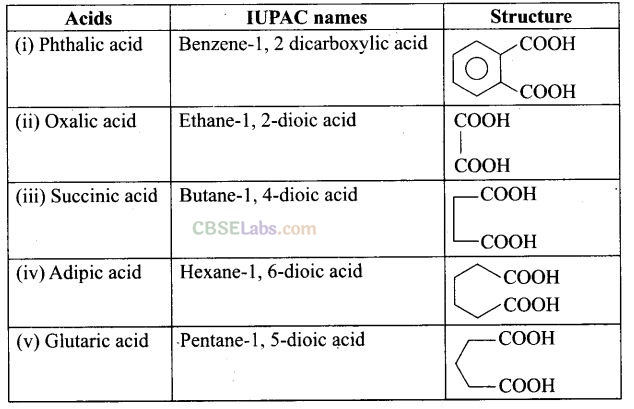
Question 40. Match the reactions given in Column I with the suitable reagents given in Column II.

Solution:
(i —> c), (ii —> d), (iii —> a), (iv —» b)
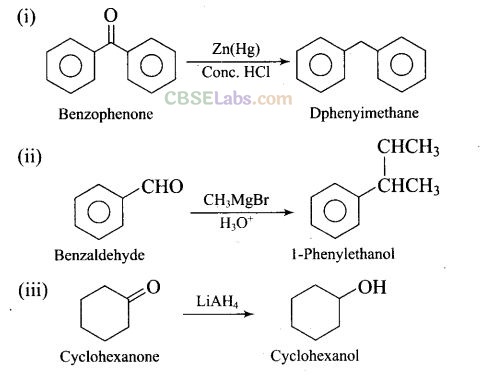

Question 41. Match the example given in Column I with the name of the reaction in Column II.
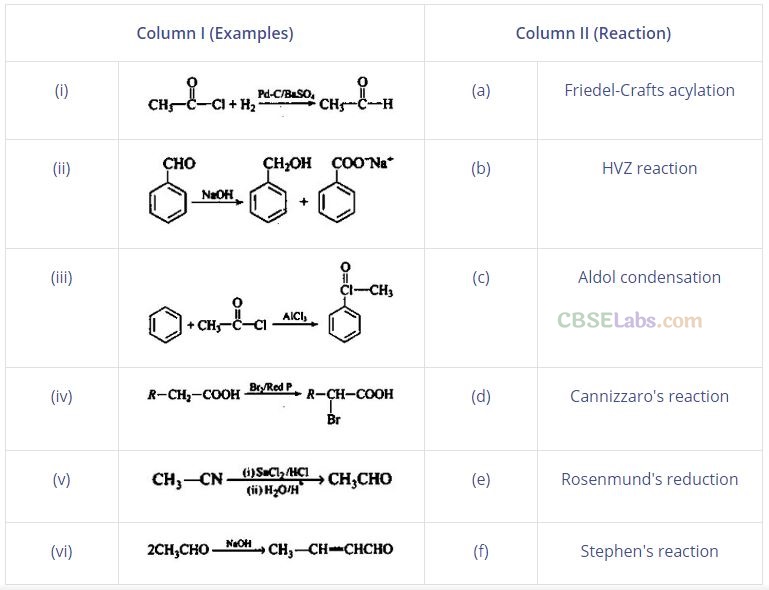
Solution:
(i —> e), (ii -» d), (iii -> a), (iv b), (v -> f), (vi —> d)
Assertion and Reason Type Questions
In the following questions, a statement of Assertion (A) followed by a statement of Reason (R) is given. Choose the correct answer out of the following choices:
(a) Assertion and Reason both are correct and Reason is the correct explanation of Assertion.
(b) Assertion and Reason both are wrong.
(c) Assertion is correct but Reason is wrong.
(d) Assertion is wrong but Reason is correct.
(e) Assertion and Reason both are correct statements but Reason is not the correct explanation of Assertion.
Question 42. Assertion (A): Formaldehyde is a planar molecule.
Reason (R): It contains sp
2
hybridised carbon atom.
Solution:
(a) Formaldehyde is a planar molecule because it contains sp
2
hybridised carbon atom.
Question 43. Assertion (A): Compounds containing -CHO group are easily oxidized to corresponding carboxylic acids.
Reason (R): Carboxylic acids can be reduced to alcohols by treatment with LiAlH
4
.
Solution:
(e) Due to electron withdrawing nature of -C = O group, C — H bond in aldehydes is weak and thus can be easily oxidized to the corresponding carboxylic acids even with mild oxidizing agents like Fehling’s solution and Tollens reagents.
Question 44. Assertion (A): The a-hydrogen atom in carbonyl compounds is less acidic. Reason (R): The anion formed after the loss of a-hydrogen atom in carbonyl compounds is more acidic.
Solution:
(d) The a-hydrogen atom in carbonyl compounds is more acidic.
Question 45. Assertion (A): Aromatic aldehydes and formaldehyde undergo Cannizzaro’s reaction.
Reason (R): Aromatic aldehydes are almost as reactive as formaldehyde.
Solution:
(c) Aromatic aldehydes and formaldehyde do not contain a-hydrogen and thus undergo Cannizzaro’s reaction. Formaldehyde is more reactive than aromatic aldehydes.
Question 46. Assertion (A): Aldehydes and ketones, both react with Tollen’s reagent to form silver mirror.
Reason (R): Both, aldehydes and ketones contain a carbonyl group.
Solution:
(d) Both aldehyde and ketones have carbonyl group but only aldehydes react with Tollen’s reagent to give silver mirror.
Long Answer Type Questions
Question 47. An alkene ‘A’ (Molecular formula C
5
H
10
) on ozonolysis gives a mixture of two compounds ‘B’ and ‘C’. Compound ‘B’ gives positive Fehling’s test and also forms iodoform on treatment with I2 and NaOH. Compound ‘C’ does not give Fehling’s test but forms iodoform. Identify the compounds A, B and C. Write the reaction for ozonolysis and formation of iodoform from B and C.
Solution:
Compound B gives positive Fehling’s test. It shows that it is an aldehyde and gives iodoform test which shows it has -COCH
3
group. Compounds C is a ketone because it does not give Fehling’s test but gives iodoform test which shows it also has -COCH
3
groups.

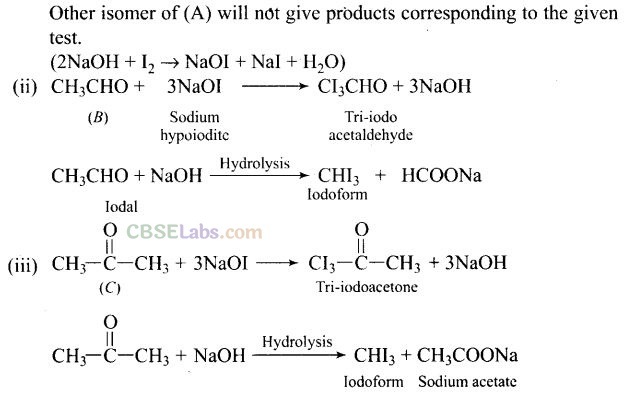
Question 48. An aromatic compound ‘A’ (Molecular formula CgHgO) gives positive 2, 4-DNP test. It gives a yellow precipitate of compound ‘B’ on treatment with iodine and sodium hydroxide solution. Compound ‘A’ does not give Tollens or Fehling’s test. On drastic oxidation with potassium permanganate it forms a carboxylic acid ‘C’ (Molecular formula C
7
H
6
O
2
), which is also formed along with the yellow compound in the above reaction. Identify A, B and C and write all reactions involved.
Solution:
Molecular formula of compound is C
8
HgO. As ‘A’ does not give Tollens’ or Fehling’s test. It must be a ketone. It gives positive test with 2, 4-DNP and iodoform test. It means it is methyl ketone.
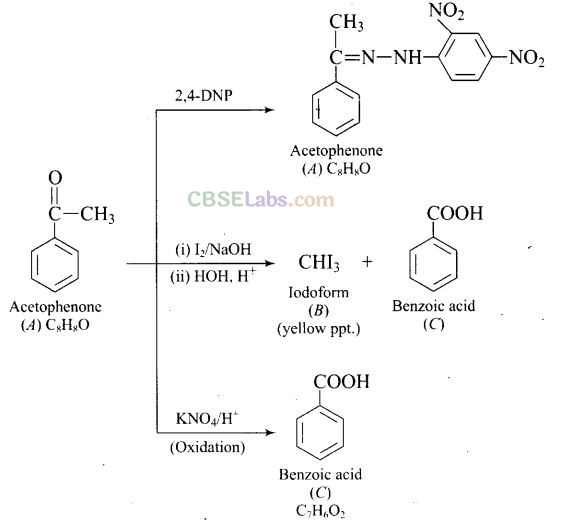
Question 49. Write down functional isomers of a carbonyl compound with molecular formula C
3
H
6
O. Which isomer will react faster with HCN and why? Explain the mechanism of the reaction also. Will the reaction lead to the completion with the conversion of whole reactant into product at reaction conditions? If a strong acid is added to the reaction mixture what will be the effect on concentration of the product and why?
Solution:
C
3
H
6
O will have following isomer.

Compound I will react faster with HCN due to less steric hindrance and greater positive charge on carbon atom of carbonyl group. Two methyl groups increase electron density on carbonyl carbon in compounds II hence the rate of nucleophilic attack is less.
Mechanism of the reaction:

The reaction will not lead to completion since it is a reversible reaction, hence equilibrium is established.
If a strong acid is added to reaction mixture, the addition is inhibited because the formation of CN” ions form HCN is prevented.
Question 50. When liquid ‘A’ is treated with a freshly prepared ammoniacal silver nitrate solution, it gives bright silver mirror. The liquid forms a white crystalline solid on treatment with sodium hydrogen sulphite. Liquid ‘B’ also forms a white crystalline solid with sodium hydrogen sulphite but it does not give test with ammoniacal silver nitrate. Which of the two liquids is aldehyde? Write the chemical equations of these reactions also.
Solution:
Liquid ‘A’ forms a bright silver mirror on treatment with ammoniacal AgNO
3
solution, therefore, liquid ‘A’ is an aldehyde.
Liquid B does not give test with ammoniacal AgNO
3
solution, therefore, liquid ‘B’ must be a methyl ketone.
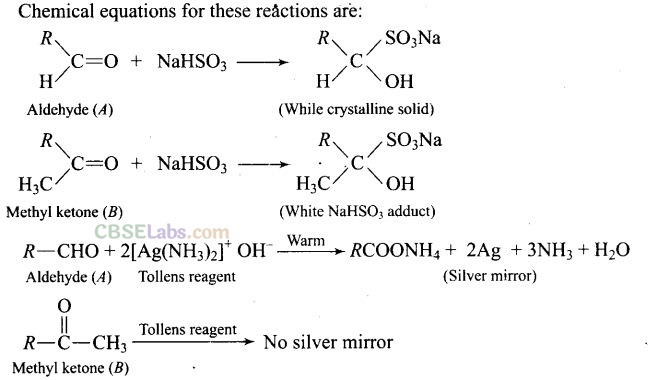
NCERT Exemplar Class 12 Chemistry Solutions
- Chapter 1 Solid State
- Chapter 2 Solution
- Chapter 3 Electrochemistry
- Chapter 4 Chemical Kinetics
- Chapter 5 Surface Chemistry
- Chapter 6 General Principles and Processes of Isolation of Elements
- Chapter 7 The p-Block Elements
- Chapter 8 The d- and f-Block Elements
- Chapter 9 Coordination Compounds
- Chapter 10 Haloalkanes and Haloarenes
- Chapter 11 Alcohols, Phenols and Ethers
- Chapter 12 Aldehydes, Ketones and Carboxylic Acids
- Chapter 13 Amines
- Chapter 14 Biomolecules
- Chapter 15 Polymers
- Chapter 16 Chemistry in Everyday Life